CAT 2020 DILR - Slot 3 Past Year Questions
CAT 2020 | DILR Set 1
DIRECTIONS for the question: Study the following information carefully and answer the given question.
Sixteen patients in a hospital must undergo a blood test for a disease. It is known that exactly one of them has the disease. The hospital has only eight testing kits and has decided to pool blood samples of patients into eight vials for the tests. The patients are numbered 1 through 16, and the vials are labelled A, B, C, D, E, F, G, and H. The following table shows the vials into which each patient’s blood sample is distributed.

If a patient has the disease, then each vial containing his/her blood sample will test positive. If a vial tests positive, one of the patients whose blood samples were mixed in the vial has the disease. If a vial tests negative, then none of the patients whose blood samples were mixed in the vial has the disease.
1. Suppose vial C tests positive and vials A, E and H test negative. Which patient has the disease?
A. Patient 2
B. Patient 6
C. Patient 14
D. Patient 8
Since vial C tests positive so the patient who has the disease has to be one of the following:- 5, 6, 7, 8, 13, 14, 15, 16, but as vial E tests negative so patients 15, 16, 7 and 8 are ruled out, similarly as vial H tests negative so patients 5 and 13 are also ruled out. Also as vial A tests negative so patients 13, 14, 15,16 are ruled out. Hence we are only left with patient 6 who has the disease.
2. Suppose vial A tests positive and vials D and G test negative. Which of the following vials should we test next to identify the patient with the disease?
A. Vial C
B. Vial H
C. Vial B
D. Vial E
Since vial A tests positive and vials D and G test negative so from the given table the only possible patients with the disease can be 13 or 15. To eliminate between 13 and 15 numbered patients vial E or F can be tested as they both have vials A, C and H, as common vials. So answer is 4th option
3. Which of the following combinations of test results is NOT possible?
A. Vial B positive, vials C, F and H negative
B. Vials B and D positive, vials F and H negative
C. Vials A and E positive, vials C and D negative
D. Vials A and G positive, vials D and E negative
Going by options, 1st option is possible and it will result into patient 4 being diseased. 2nd option is possible and it will result into patient 4, 8 or 12 being diseased 3rd option is not possible is not possible as it will result into making all the patients free from disease. 4th option is possible as it will result into patient 14 being diseased. So, 3rd option is the correct answer.
4.Suppose one of the lab assistants accidentally mixed two patients’ blood samples before they were distributed to the vials. Which of the following correctly represents the set of all possible numbers of positive test results out of the eight vials?
A. {5,6,7,8}
B. {4,5}
C. {4,5,6,7,8}
{4,5,D. 6,7}
Since every patient’s blood sample is there in 4 vials so with a mixing of two non-diseased patient’s blood samples there will be 4 vials with positive test result. If the mixing of samples includes the sample of the patient suffering from disease then the number of vials testing positive can increase and become 5, 6, 7 or 8 depending upon the number of vials further testing positive because of the mix-up being 1, 2, 3 or 4 whish were earlier testing negative in case of no mix up. So the correct answer is 3rd option
Correct Answer 1
Option B
Correct Answer 2
Option D
Correct Answer 3
Option C
Correct Answer 4
Option C
CAT 2020 | DILR Set 2
DIRECTIONS for the question: Study the following information carefully and answer the given question.
The Hi-Lo game is a four-player game played in six rounds. In every round, each player chooses to bid Hi or Lo. The bids are made simultaneously. If all four bid Hi, then all four lose 1 point each. If three players bid Hi and one bids Lo, then the players bidding Hi gain 1 point each and the player bidding Lo loses 3 points. If two players bid Hi and two bid Lo, then the players bidding Hi gain 2 points each and the players bidding Lo lose 2 points each. If one player bids Hi and three bid Lo, then the player bidding Hi gains 3 points and the players bidding Lo lose 1 point each. If all four bid Lo, then all four gain 1 point each.
Four players Arun, Bankim, Charu, and Dipak played the Hi-Lo game. The following facts are known about their game:
- At the end of three rounds, Arun had scored 6 points, Dipak had scored 2 points, Bankim and Charu had scored -2 points each.
- At the end of six rounds, Arun had scored 7 points, Bankim and Dipak had scored -1 point each, and Charu had scored -5 points.
- Dipak’s score in the third round was less than his score in the first round but was more than his score in the second round.
- In exactly two out of the six rounds, Arun was the only player who bid Hi.
5. What were the bids by Arun, Bankim, Charu and Dipak, respectively in the first round?
- Lo, Lo, Lo, Hi
- Hi, Lo, Lo, Hi
- Hi, Hi, Lo, Lo
- Hi, Lo, Lo, Lo
As per the given conditions the table of first three rounds is given So, at the end of three rounds, Arun had scored 6 points, Dipak had scored 2 points, Bankim
and Charu had scored -2 points each. Now with the further condition being given that at the
end of six rounds, Arun had scored 7 points. Bankim and Dipak had scored 7 points, also with
the condition that there has to be one more round after the first three rounds in which Arun was
the only player who bid Hi, we can have the following combinations for Rounds 4, 5 & 6.
Refer to table I.
So, at the end of three rounds, Arun had scored 6 points, Dipak had scored 2 points, Bankim
and Charu had scored -2 points each. Now with the further condition being given that at the
end of six rounds, Arun had scored 7 points. Bankim and Dipak had scored 7 points, also with
the condition that there has to be one more round after the first three rounds in which Arun was
the only player who bid Hi, we can have the following combinations for Rounds 4, 5 & 6.
Refer to table I.
6. In how many rounds did Arun bid Hi? (in numerical value)
As per the given conditions the table of first three rounds is given below
 So, at the end of three rounds, Arun had scored 6 points, Dipak had scored 2 points, Bankim and Charu had scored -2 points each. Now with the further condition being given that at the end of six rounds, Arun had scored 7 points. Bankim and Dipak had scored 7 points, also with the condition that there has to be one more round after the first three rounds in which Arun was the only player who bid Hi, we can have the following combinations for Rounds 4, 5 & 6.
So, at the end of three rounds, Arun had scored 6 points, Dipak had scored 2 points, Bankim and Charu had scored -2 points each. Now with the further condition being given that at the end of six rounds, Arun had scored 7 points. Bankim and Dipak had scored 7 points, also with the condition that there has to be one more round after the first three rounds in which Arun was the only player who bid Hi, we can have the following combinations for Rounds 4, 5 & 6.
 Arun bid Hi in 4 rounds.
Arun bid Hi in 4 rounds.
7. In how many rounds did Bankim bid Lo? (in numerical value)
As per the given conditions the table of first three rounds is given below
 So, at the end of three rounds, Arun had scored 6 points, Dipak had scored 2 points, Bankim and Charu had scored -2 points each. Now with the further condition being given that at the end of six rounds, Arun had scored 7 points. Bankim and Dipak had scored 7 points, also with the condition that there has to be one more round after the first three rounds in which Arun was the only player who bid Hi, we can have the following combinations for Rounds 4, 5 & 6.
Bankim bid Lo in 4 rounds
So, at the end of three rounds, Arun had scored 6 points, Dipak had scored 2 points, Bankim and Charu had scored -2 points each. Now with the further condition being given that at the end of six rounds, Arun had scored 7 points. Bankim and Dipak had scored 7 points, also with the condition that there has to be one more round after the first three rounds in which Arun was the only player who bid Hi, we can have the following combinations for Rounds 4, 5 & 6.
Bankim bid Lo in 4 rounds
8. In how many rounds did all four players make identical bids? (in numerical value)
As per the given conditions the table of first three rounds is given below
 So, at the end of three rounds, Arun had scored 6 points, Dipak had scored 2 points, Bankim and Charu had scored -2 points each. Now with the further condition being given that at the end of six rounds, Arun had scored 7 points. Bankim and Dipak had scored 7 points, also with the condition that there has to be one more round after the first three rounds in which Arun was the only player who bid Hi, we can have the following combinations for Rounds 4, 5 & 6.
All four players made identical bids in Round 3 and once again in one of rounds 4, 5 or 6. So this happened in 2 rounds.
So, at the end of three rounds, Arun had scored 6 points, Dipak had scored 2 points, Bankim and Charu had scored -2 points each. Now with the further condition being given that at the end of six rounds, Arun had scored 7 points. Bankim and Dipak had scored 7 points, also with the condition that there has to be one more round after the first three rounds in which Arun was the only player who bid Hi, we can have the following combinations for Rounds 4, 5 & 6.
All four players made identical bids in Round 3 and once again in one of rounds 4, 5 or 6. So this happened in 2 rounds.
9.In how many rounds did Dipak gain exactly 1 point? (in numerical value)
As per the given conditions the table of first three rounds is given below
 So, at the end of three rounds, Arun had scored 6 points, Dipak had scored 2 points, Bankim and Charu had scored -2 points each. Now with the further condition being given that at the end of six rounds, Arun had scored 7 points. Bankim and Dipak had scored 7 points, also with the condition that there has to be one more round after the first three rounds in which Arun was the only player who bid Hi, we can have the following combinations for Rounds 4, 5 & 6.
Dipak gained exactly 1 point only in round 3. So this happened only in one of the rounds.
So, at the end of three rounds, Arun had scored 6 points, Dipak had scored 2 points, Bankim and Charu had scored -2 points each. Now with the further condition being given that at the end of six rounds, Arun had scored 7 points. Bankim and Dipak had scored 7 points, also with the condition that there has to be one more round after the first three rounds in which Arun was the only player who bid Hi, we can have the following combinations for Rounds 4, 5 & 6.
Dipak gained exactly 1 point only in round 3. So this happened only in one of the rounds.
10. In which of the following rounds, was Arun DEFINITELY the only player to bid Hi?
- Second
- Fourth
- Third
- First
As per the given conditions the table of first three rounds is given below
 So, at the end of three rounds, Arun had scored 6 points, Dipak had scored 2 points, Bankim and Charu had scored -2 points each. Now with the further condition being given that at the end of six rounds, Arun had scored 7 points. Bankim and Dipak had scored 7 points, also with the condition that there has to be one more round after the first three rounds in which Arun was the only player who bid Hi, we can have the following combinations for Rounds 4, 5 & 6.
So, at the end of three rounds, Arun had scored 6 points, Dipak had scored 2 points, Bankim and Charu had scored -2 points each. Now with the further condition being given that at the end of six rounds, Arun had scored 7 points. Bankim and Dipak had scored 7 points, also with the condition that there has to be one more round after the first three rounds in which Arun was the only player who bid Hi, we can have the following combinations for Rounds 4, 5 & 6.
 The only round we are sure about Arun being the only player to bid Hi so answer is 1st option.
The only round we are sure about Arun being the only player to bid Hi so answer is 1st option.
Correct Answer 5
Option B
Correct Answer 6
4
Correct Answer 7
4
Correct Answer 8
2
Correct Answer 9
1
Correct Answer 10
Option A
CAT 2020 | DILR Set 3
DIRECTIONS for the question: Solve the following question and mark the best possible option.
A survey of 600 schools in India was conducted to gather information about their online teaching learning processes (OTLP). The following four facilities were studied.
F1: Own software for OTLP
F2: Trained teachers for OTLP
F3: Training materials for OTLP
F4: All students having Laptops
The following observations were summarized from the survey.
- 80 schools did not have any of the four facilities – F1, F2, F3, F4.
- 40 schools had all four facilities.
- The number of schools with only F1, only F2, only F3, and only F4 was 25, 30, 26 and 20 respectively.
- The number of schools with exactly three of the facilities was the same irrespective of which three were considered.
- 313 schools had F2.
- 26 schools had only F2 and F3 (but neither F1 nor F4).
- Among the schools having F4, 24 had only F3, and 45 had only F2.
- 162 schools had both F1 and F2.
- The number of schools having F1 was the same as the number of schools having F4.
11. What was the total number of schools having exactly three of the four facilities?
- 200
- 50
- 64
- 80
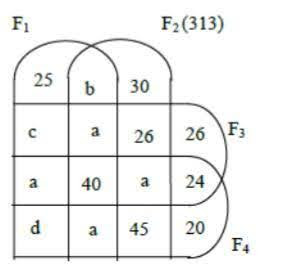 Number of schools who do not have any of these 4 facilities = 80
2a + 40 + b = 162..........(1)
162 + 30 + 26 + a + 45 = 313.......(2). So a = 50.
Putting this value of a in equation (1), we get b = 22.
As the number of schools having F1 was the same as the number of schools having F4, so 25 + c + a + d + b + a + 40 + a = a + 40 + a + 24 + d + a + 45 + 20
Þ25 + c + 22 + 40 = 129 Þ c = 42.
Also 25 + c + a + d + 162 + 30 + 26 + a + 45 + 26 + 24 + 20 + 80 = 600
⇒ 25 + 42 + 50 + d + 162 + 30 + 26 + 50 + 45 + 26 + 24 + 20 + 20 + 80 = 600 ⇒ d = 20 So we get the final diagram as follows:
Number of schools who do not have any of these 4 facilities = 80
2a + 40 + b = 162..........(1)
162 + 30 + 26 + a + 45 = 313.......(2). So a = 50.
Putting this value of a in equation (1), we get b = 22.
As the number of schools having F1 was the same as the number of schools having F4, so 25 + c + a + d + b + a + 40 + a = a + 40 + a + 24 + d + a + 45 + 20
Þ25 + c + 22 + 40 = 129 Þ c = 42.
Also 25 + c + a + d + 162 + 30 + 26 + a + 45 + 26 + 24 + 20 + 80 = 600
⇒ 25 + 42 + 50 + d + 162 + 30 + 26 + 50 + 45 + 26 + 24 + 20 + 20 + 80 = 600 ⇒ d = 20 So we get the final diagram as follows:
 Number of schools having exactly three of the four facilities = 50 + 50 + 50 + 50 = 200
Number of schools having exactly three of the four facilities = 50 + 50 + 50 + 50 = 200
12. What was the number of schools having facilities F2 and F4?
- 85
- 95
- 45
- 185
Number of schools who do not have any of these 4 facilities = 80
2a + 40 + b = 162..........(1)
162 + 30 + 26 + a + 45 = 313.......(2). So a = 50.
Putting this value of a in equation (1), we get b = 22.
As the number of schools having F1 was the same as the number of schools having F4, so 25 + c + a + d + b + a + 40 + a = a + 40 + a + 24 + d + a + 45 + 20
Þ25 + c + 22 + 40 = 129 Þ c = 42.
Also 25 + c + a + d + 162 + 30 + 26 + a + 45 + 26 + 24 + 20 + 80 = 600
⇒ 25 + 42 + 50 + d + 162 + 30 + 26 + 50 + 45 + 26 + 24 + 20 + 20 + 80 = 600 ⇒ d = 20 So we get the final diagram as follows:
 Number of schools having facilities F2 and F4 = 40 + 50 + 50 + 45 = 185
Number of schools having facilities F2 and F4 = 40 + 50 + 50 + 45 = 185
13. What was the number of schools having only facilities F1 and F3? (in numerical value)
Number of schools who do not have any of these 4 facilities = 80
 2a + 40 + b = 162..........(1)
162 + 30 + 26 + a + 45 = 313.......(2). So a = 50.
Putting this value of a in equation (1), we get b = 22.
As the number of schools having F1 was the same as the number of schools having F4, so 25 + c + a + d + b + a + 40 + a = a + 40 + a + 24 + d + a + 45 + 20
Þ25 + c + 22 + 40 = 129 Þ c = 42.
Also 25 + c + a + d + 162 + 30 + 26 + a + 45 + 26 + 24 + 20 + 80 = 600
⇒ 25 + 42 + 50 + d + 162 + 30 + 26 + 50 + 45 + 26 + 24 + 20 + 20 + 80 = 600 ⇒ d = 20
So we get the final diagram as follows:
Number of schools having only facilities F1 and F3 = 42
2a + 40 + b = 162..........(1)
162 + 30 + 26 + a + 45 = 313.......(2). So a = 50.
Putting this value of a in equation (1), we get b = 22.
As the number of schools having F1 was the same as the number of schools having F4, so 25 + c + a + d + b + a + 40 + a = a + 40 + a + 24 + d + a + 45 + 20
Þ25 + c + 22 + 40 = 129 Þ c = 42.
Also 25 + c + a + d + 162 + 30 + 26 + a + 45 + 26 + 24 + 20 + 80 = 600
⇒ 25 + 42 + 50 + d + 162 + 30 + 26 + 50 + 45 + 26 + 24 + 20 + 20 + 80 = 600 ⇒ d = 20
So we get the final diagram as follows:
Number of schools having only facilities F1 and F3 = 42

14. What was the number of schools having only facilities F1 and F4? (in numerical value)
Number of schools who do not have any of these 4 facilities = 80
 2a + 40 + b = 162..........(1)
162 + 30 + 26 + a + 45 = 313.......(2). So a = 50. Putting this value of a in equation (1), we get b = 22.
As the number of schools having F1 was the same as the number of schools having F4, so 25 + c + a + d + b + a + 40 + a = a + 40 + a + 24 + d + a + 45 + 20
Þ25 + c + 22 + 40 = 129 Þ c = 42.
Also 25 + c + a + d + 162 + 30 + 26 + a + 45 + 26 + 24 + 20 + 80 = 600
⇒ 25 + 42 + 50 + d + 162 + 30 + 26 + 50 + 45 + 26 + 24 + 20 + 20 + 80 = 600 ⇒ d = 20 So we get the final diagram as follows:
2a + 40 + b = 162..........(1)
162 + 30 + 26 + a + 45 = 313.......(2). So a = 50. Putting this value of a in equation (1), we get b = 22.
As the number of schools having F1 was the same as the number of schools having F4, so 25 + c + a + d + b + a + 40 + a = a + 40 + a + 24 + d + a + 45 + 20
Þ25 + c + 22 + 40 = 129 Þ c = 42.
Also 25 + c + a + d + 162 + 30 + 26 + a + 45 + 26 + 24 + 20 + 80 = 600
⇒ 25 + 42 + 50 + d + 162 + 30 + 26 + 50 + 45 + 26 + 24 + 20 + 20 + 80 = 600 ⇒ d = 20 So we get the final diagram as follows:
 Number of schools having only facilities F1 and F4 = 20
Number of schools having only facilities F1 and F4 = 20
Correct Answer 11
Option A
Correct Answer 12
Option D
Correct Answer 13
42
Correct Answer 14
20
CAT 2020 | DILR Set 4
DIRECTIONS for the question: Read the information given below and answer the question that follows.
XYZ organization got into the business of delivering groceries to home at the beginning of the last month. They have a two-day delivery promise. However, their deliveries are unreliable. An order booked on a particular day may be delivered the next day or the day after. If the order is not delivered at the end of two days, then the order is declared as lost at the end of the second day. XYZ then does not deliver the order, but informs the customer, marks the order as lost, returns the payment and pays a penalty for non-delivery.
The following table provides details about the operations of XYZ for a week of the last month. The first column gives the date, the second gives the cumulative number of orders that were booked up to and including that day. The third column represents the number of orders delivered on that day. The last column gives the cumulative number of orders that were lost up to and including that day.
It is known that the numbers of orders that were booked on the 11th, 12th, and 13th of the last month that took two days to deliver were 4, 6, and 8 respectively.
15. Among the following days, the largest fraction of orders booked on which day was lost?
- 13th
- 16th
- 15th
- 14th
Firstly we will convert the cumulative values to normal frequency model. So the new table becomes
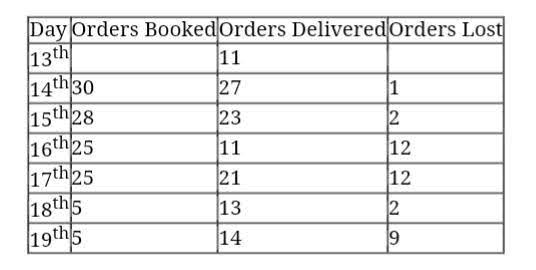 As is given that number of orders that were booked on 11th, 12th and 13th of the last month that took 2 days to deliver were 4, 6 and 8 respectively, so we can say that on the 13th day, the breakup of 11 orders which were delivered will be 4 + 7. Hence the remaining 7 orders must have been booked on 12th day.
Similarly, we can get the breakup of 27 orders which were delivered on 14th day will be 6 + 21. Hence the remaining 21 orders must have been booked on 13th day.
Similarly, we can get the breakup of 23 orders which were delivered on 15th day will be 8 + 15. Hence the remaining 15 orders must have been booked on 14th day.
But we can see that there are 2 orders which are lost on 15th day. These must have been booked on 13th day.
As 12 orders on 16th day are lost, so they must have been booked on 14th day. So we can say that breakup of 11 orders on day 16 will be 3 + 8. Hence 3 orders delivered on 16th day must have been ordered on 14th day and remaining 8 orders must have been booked on 15th day.
Moving in this pattern, we can find the breakup of 17th, 18th and 19th day and we can get the final table as follows:
As is given that number of orders that were booked on 11th, 12th and 13th of the last month that took 2 days to deliver were 4, 6 and 8 respectively, so we can say that on the 13th day, the breakup of 11 orders which were delivered will be 4 + 7. Hence the remaining 7 orders must have been booked on 12th day.
Similarly, we can get the breakup of 27 orders which were delivered on 14th day will be 6 + 21. Hence the remaining 21 orders must have been booked on 13th day.
Similarly, we can get the breakup of 23 orders which were delivered on 15th day will be 8 + 15. Hence the remaining 15 orders must have been booked on 14th day.
But we can see that there are 2 orders which are lost on 15th day. These must have been booked on 13th day.
As 12 orders on 16th day are lost, so they must have been booked on 14th day. So we can say that breakup of 11 orders on day 16 will be 3 + 8. Hence 3 orders delivered on 16th day must have been ordered on 14th day and remaining 8 orders must have been booked on 15th day.
Moving in this pattern, we can find the breakup of 17th, 18th and 19th day and we can get the final table as follows:
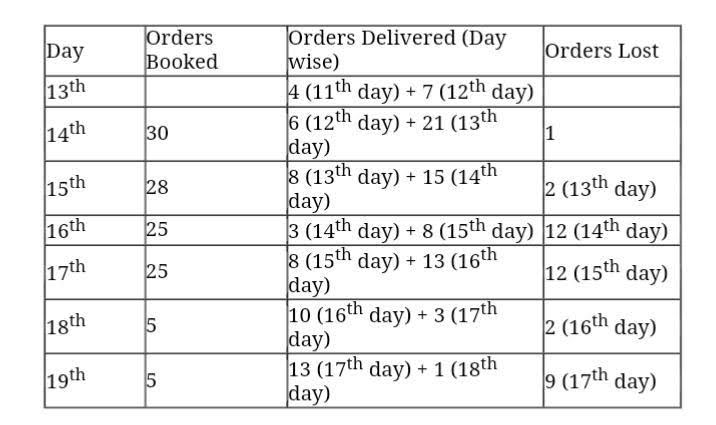 Now we can find the number of orders booked on 13th day = 21 + 2 + 8 = 31. Now we can find all the answers.
Orders lost as a fraction of orders booked was maximum on 15th day which is equal to 12/28.
Now we can find the number of orders booked on 13th day = 21 + 2 + 8 = 31. Now we can find all the answers.
Orders lost as a fraction of orders booked was maximum on 15th day which is equal to 12/28.
16. On which of the following days was the number of orders booked the highest?
- 15th
- 13th
- 14th
- 12th
Firstly we will convert the cumulative values to normal frequency model. So the new table becomes
 As is given that number of orders that were booked on 11th, 12th and 13th of the last month that took 2 days to deliver were 4, 6 and 8 respectively, so we can say that on the 13th day, the breakup of 11 orders which were delivered will be 4 + 7. Hence the remaining 7 orders must have been booked on 12th day.
Similarly, we can get the breakup of 27 orders which were delivered on 14th day will be 6 + 21. Hence the remaining 21 orders must have been booked on 13th day.
Similarly, we can get the breakup of 23 orders which were delivered on 15th day will be 8 + 15. Hence the remaining 15 orders must have been booked on 14th day.
But we can see that there are 2 orders which are lost on 15th day. These must have been booked on 13th day.
As 12 orders on 16th day are lost, so they must have been booked on 14th day. So we can say that breakup of 11 orders on day 16 will be 3 + 8. Hence 3 orders delivered on 16th day must have been ordered on 14th day and remaining 8 orders must have been booked on 15th day.
Moving in this pattern, we can find the breakup of 17th, 18th and 19th day and we can get the final table as follows::
Now we can find the number of orders booked on 13th day = 21 + 8 + 2 = 31. Now we can find all the answers:
As is given that number of orders that were booked on 11th, 12th and 13th of the last month that took 2 days to deliver were 4, 6 and 8 respectively, so we can say that on the 13th day, the breakup of 11 orders which were delivered will be 4 + 7. Hence the remaining 7 orders must have been booked on 12th day.
Similarly, we can get the breakup of 27 orders which were delivered on 14th day will be 6 + 21. Hence the remaining 21 orders must have been booked on 13th day.
Similarly, we can get the breakup of 23 orders which were delivered on 15th day will be 8 + 15. Hence the remaining 15 orders must have been booked on 14th day.
But we can see that there are 2 orders which are lost on 15th day. These must have been booked on 13th day.
As 12 orders on 16th day are lost, so they must have been booked on 14th day. So we can say that breakup of 11 orders on day 16 will be 3 + 8. Hence 3 orders delivered on 16th day must have been ordered on 14th day and remaining 8 orders must have been booked on 15th day.
Moving in this pattern, we can find the breakup of 17th, 18th and 19th day and we can get the final table as follows::
Now we can find the number of orders booked on 13th day = 21 + 8 + 2 = 31. Now we can find all the answers:
 We can see that highest number of orders were booked on 13th day i.e 31.
We can see that highest number of orders were booked on 13th day i.e 31.
17. The delivery ratio for a given day is defined as the ratio of the number of orders booked on that day which are delivered on the next day to the number of orders booked on that day which are delivered on the second day after booking. On which of the following days, was the delivery ratio the highest?
- 13th
- 15th
- 14th
- 16th
Firstly we will convert the cumulative values to normal frequency model. So the new table becomes
 As is given that number of orders that were booked on 11th, 12th and 13th of the last month that took 2 days to deliver were 4, 6 and 8 respectively, so we can say that on the 13th day, the breakup of 11 orders which were delivered will be 4 + 7. Hence the remaining 7 orders must have been booked on 12th day.
Similarly, we can get the breakup of 27 orders which were delivered on 14th day will be 6 + 21. Hence the remaining 21 orders must have been booked on 13th day.
Similarly, we can get the breakup of 23 orders which were delivered on 15th day will be 8 + 15. Hence the remaining 15 orders must have been booked on 14th day.
But we can see that there are 2 orders which are lost on 15th day. These must have been booked on 13th day.
As 12 orders on 16th day are lost, so they must have been booked on 14th day. So we can say that breakup of 11 orders on day 16 will be 3 + 8. Hence 3 orders delivered on 16th day must have been ordered on 14th day and remaining 8 orders must have been booked on 15th day.
Moving in this pattern, we can find the breakup of 17th, 18th and 19th day and we can get the final table as follows::
Now we can find the number of orders booked on 13th day = 21 + 8 + 2 = 31. Now we can find all the answers:
As is given that number of orders that were booked on 11th, 12th and 13th of the last month that took 2 days to deliver were 4, 6 and 8 respectively, so we can say that on the 13th day, the breakup of 11 orders which were delivered will be 4 + 7. Hence the remaining 7 orders must have been booked on 12th day.
Similarly, we can get the breakup of 27 orders which were delivered on 14th day will be 6 + 21. Hence the remaining 21 orders must have been booked on 13th day.
Similarly, we can get the breakup of 23 orders which were delivered on 15th day will be 8 + 15. Hence the remaining 15 orders must have been booked on 14th day.
But we can see that there are 2 orders which are lost on 15th day. These must have been booked on 13th day.
As 12 orders on 16th day are lost, so they must have been booked on 14th day. So we can say that breakup of 11 orders on day 16 will be 3 + 8. Hence 3 orders delivered on 16th day must have been ordered on 14th day and remaining 8 orders must have been booked on 15th day.
Moving in this pattern, we can find the breakup of 17th, 18th and 19th day and we can get the final table as follows::
Now we can find the number of orders booked on 13th day = 21 + 8 + 2 = 31. Now we can find all the answers:
 Delivery Ratio is highest for 14th day which is equal to 15 : 3 i.e. 5 : 1. Hence 3rd option.
Delivery Ratio is highest for 14th day which is equal to 15 : 3 i.e. 5 : 1. Hence 3rd option.
18. The average time taken to deliver orders booked on a particular day is computed as follows. Let the number of orders delivered the next day be x and the number of orders delivered the day after be y. Then the average time to deliver order is (x+2y)/(x+y). On which of the following days was the average time taken to deliver orders booked the least?
- 16th
- 15th
- 13th
- 14th
Firstly we will convert the cumulative values to normal frequency model. So the new table becomes
 As is given that number of orders that were booked on 11th, 12th and 13th of the last month that took 2 days to deliver were 4, 6 and 8 respectively, so we can say that on the 13th day, the breakup of 11 orders which were delivered will be 4 + 7. Hence the remaining 7 orders must have been booked on 12th day.
Similarly, we can get the breakup of 27 orders which were delivered on 14th day will be 6 + 21. Hence the remaining 21 orders must have been booked on 13th day.
Similarly, we can get the breakup of 23 orders which were delivered on 15th day will be 8 + 15. Hence the remaining 15 orders must have been booked on 14th day.
But we can see that there are 2 orders which are lost on 15th day. These must have been booked on 13th day.
As 12 orders on 16th day are lost, so they must have been booked on 14th day. So we can say that breakup of 11 orders on day 16 will be 3 + 8. Hence 3 orders delivered on 16th day must have been ordered on 14th day and remaining 8 orders must have been booked on 15th day.
Moving in this pattern, we can find the breakup of 17th, 18th and 19th day and we can get the final table as follows::
Now we can find the number of orders booked on 13th day = 21 + 8 + 2 = 31. Now we can find all the answers:
As is given that number of orders that were booked on 11th, 12th and 13th of the last month that took 2 days to deliver were 4, 6 and 8 respectively, so we can say that on the 13th day, the breakup of 11 orders which were delivered will be 4 + 7. Hence the remaining 7 orders must have been booked on 12th day.
Similarly, we can get the breakup of 27 orders which were delivered on 14th day will be 6 + 21. Hence the remaining 21 orders must have been booked on 13th day.
Similarly, we can get the breakup of 23 orders which were delivered on 15th day will be 8 + 15. Hence the remaining 15 orders must have been booked on 14th day.
But we can see that there are 2 orders which are lost on 15th day. These must have been booked on 13th day.
As 12 orders on 16th day are lost, so they must have been booked on 14th day. So we can say that breakup of 11 orders on day 16 will be 3 + 8. Hence 3 orders delivered on 16th day must have been ordered on 14th day and remaining 8 orders must have been booked on 15th day.
Moving in this pattern, we can find the breakup of 17th, 18th and 19th day and we can get the final table as follows::
Now we can find the number of orders booked on 13th day = 21 + 8 + 2 = 31. Now we can find all the answers:
 Average time taken as given in the question is least for 14th day which is equal to
Average time taken as given in the question is least for 14th day which is equal to

Correct Answer 15
Option C
Correct Answer 16
Option B
Correct Answer 17
Option C
Correct Answer 18
Option D
CAT 2020 | DILR Set 5
DIRECTIONS for the question: Read the information given below and answer the question that follows.
A farmer had a rectangular land containing 205 trees. He distributed that land among his four daughters – Abha, Bina, Chitra and Dipti by dividing the land into twelve plots along three rows (X,Y,Z) and four Columns (1,2,3,4) as shown in the figure below:
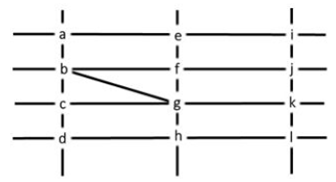
The plots in rows X, Y, Z contained mango, teak and pine trees respectively. Each plot had trees in non-zero multiples of 3 or 4 and none of the plots had the same number of trees. Each daughter got an even number of plots. In the figure, the number mentioned in top left corner of a plot is the number of trees in that plot, while the letter in the bottom right corner is the first letter of the name of the daughter who got that plot (For example, Abha got the plot in row Y and column 1 containing 21 trees). Some information in the figure got erased, but the following is known:
- Abha got 20 trees more than Chitra but 6 trees less than Dipti.
- The largest number of trees in a plot was 32, but it was not with Abha.
- The number of teak trees in Column 3 was double of that in Column 2 but was half of that in Column 4.
- Both Abha and Bina got a higher number of plots than Dipti.
- Only Bina, Chitra and Dipti got corner plots.
- Dipti got two adjoining plots in the same row.
- Bina was the only one who got a plot in each row and each column.
- Chitra and Dipti did not get plots which were adjacent to each other (either in row / column / diagonal).
- The number of mango trees was double the number of teak trees.
19. How many mango trees were there in total?
- 49
- 98
- 126
- 84
Given
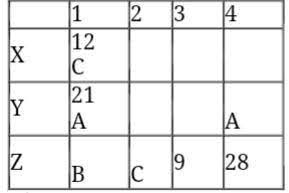 Total number of trees = 205
A – C = 20 and D – A = 6 (from condition 1)
Let number of teak trees in column 2,3 and 4 is x, 2x and 4x respectively (from condition 3)
From condition 6 and 8, only possible plots for D is Row 1, column 3 and 4
From condition 7, plots for Bina are Row 1 column 2, Row 3 column 4 and Row 2 column 3. So Bina got 4 plots.
From condition 4 Abha and Dipti got 4 and 2 plots respectively.
(as each daughter got an even number of plots)
Using all conditions we get, number of plots as A = 4, B = 4, C = 2 and D = 2
Total number of trees = 205
A – C = 20 and D – A = 6 (from condition 1)
Let number of teak trees in column 2,3 and 4 is x, 2x and 4x respectively (from condition 3)
From condition 6 and 8, only possible plots for D is Row 1, column 3 and 4
From condition 7, plots for Bina are Row 1 column 2, Row 3 column 4 and Row 2 column 3. So Bina got 4 plots.
From condition 4 Abha and Dipti got 4 and 2 plots respectively.
(as each daughter got an even number of plots)
Using all conditions we get, number of plots as A = 4, B = 4, C = 2 and D = 2
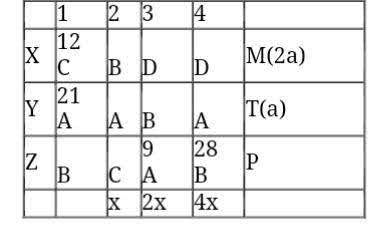 Now as each plot had trees in non-zero multiples of 3 or 4 and none of the plots had the same number of trees. So we cannot take x as 3 or 6.
If x = 4 then 2x = 8 and 4x = 16
Now as each plot had trees in non-zero multiples of 3 or 4 and none of the plots had the same number of trees. So we cannot take x as 3 or 6.
If x = 4 then 2x = 8 and 4x = 16
 So we have A = 50
From condition 1, C = 30 and D = 56 Þ B = 69
So we have
So we have A = 50
From condition 1, C = 30 and D = 56 Þ B = 69
So we have
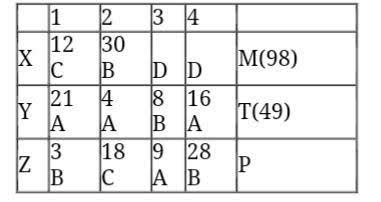 There are 98 mango trees in total
There are 98 mango trees in total
20. Which of the following is the correct sequence of trees received by Abha, Bina, Chitra and Dipti in that order?
- 60, 39, 40, 66
- 50, 69, 30, 56
- 44, 87, 24, 50
- 54, 57, 34, 60
Given
 Total number of trees = 205
A – C = 20 and D – A = 6 (from condition 1)
Let number of teak trees in column 2,3 and 4 is x, 2x and 4x respectively (from condition 3)
From condition 6 and 8, only possible plots for D is Row 1, column 3 and 4
From condition 7, plots for Bina are Row 1 column 2, Row 3 column 4 and Row 2 column 3. So Bina got 4 plots.
From condition 4 Abha and Dipti got 4 and 2 plots respectively.
(as each daughter got an even number of plots)
Using all conditions we get, number of plots as A = 4, B = 4, C = 2 and D = 2
Total number of trees = 205
A – C = 20 and D – A = 6 (from condition 1)
Let number of teak trees in column 2,3 and 4 is x, 2x and 4x respectively (from condition 3)
From condition 6 and 8, only possible plots for D is Row 1, column 3 and 4
From condition 7, plots for Bina are Row 1 column 2, Row 3 column 4 and Row 2 column 3. So Bina got 4 plots.
From condition 4 Abha and Dipti got 4 and 2 plots respectively.
(as each daughter got an even number of plots)
Using all conditions we get, number of plots as A = 4, B = 4, C = 2 and D = 2
 Now as each plot had trees in non-zero multiples of 3 or 4 and none of the plots had the same number of trees. So we cannot take x as 3 or 6.
If x = 4 then 2x = 8 and 4x = 16
Now as each plot had trees in non-zero multiples of 3 or 4 and none of the plots had the same number of trees. So we cannot take x as 3 or 6.
If x = 4 then 2x = 8 and 4x = 16
 So we have A = 50
From condition 1, C = 30 and D = 56 Þ B = 69
So we have
So we have A = 50
From condition 1, C = 30 and D = 56 Þ B = 69
So we have
 50, 69, 30, 56 is the correct sequence of trees received by Abha, Bina, Chitra and Dipti
50, 69, 30, 56 is the correct sequence of trees received by Abha, Bina, Chitra and Dipti
21. How many pine trees did Chitra receive?
- 18
- 15
- 21
- 30
Given Total number of trees = 205
A – C = 20 and D – A = 6 (from condition 1)
Let number of teak trees in column 2,3 and 4 is x, 2x and 4x respectively (from condition 3)
From condition 6 and 8, only possible plots for D is Row 1, column 3 and 4
From condition 7, plots for Bina are Row 1 column 2, Row 3 column 4 and Row 2 column 3. So Bina got 4 plots.
From condition 4 Abha and Dipti got 4 and 2 plots respectively.
(as each daughter got an even number of plots)
Using all conditions we get, number of plots as A = 4, B = 4, C = 2 and D = 2
Total number of trees = 205
A – C = 20 and D – A = 6 (from condition 1)
Let number of teak trees in column 2,3 and 4 is x, 2x and 4x respectively (from condition 3)
From condition 6 and 8, only possible plots for D is Row 1, column 3 and 4
From condition 7, plots for Bina are Row 1 column 2, Row 3 column 4 and Row 2 column 3. So Bina got 4 plots.
From condition 4 Abha and Dipti got 4 and 2 plots respectively.
(as each daughter got an even number of plots)
Using all conditions we get, number of plots as A = 4, B = 4, C = 2 and D = 2
 Now as each plot had trees in non-zero multiples of 3 or 4 and none of the plots had the same number of trees. So we cannot take x as 3 or 6.
If x = 4 then 2x = 8 and 4x = 16
Now as each plot had trees in non-zero multiples of 3 or 4 and none of the plots had the same number of trees. So we cannot take x as 3 or 6.
If x = 4 then 2x = 8 and 4x = 16
 So we have A = 50
From condition 1, C = 30 and D = 56 Þ B = 69
So we have A = 50
From condition 1, C = 30 and D = 56 Þ B = 69
 Chitra receives 18 pine trees.
Chitra receives 18 pine trees.
22. Who got the plot with the smallest number of trees and how many trees did that plot have?
- Bina, 3 trees
- Dipti, 6 trees
- Abha, 4 trees
- Bina, 4 trees
Given
 Total number of trees = 205
A – C = 20 and D – A = 6 (from condition 1)
Let number of teak trees in column 2,3 and 4 is x, 2x and 4x respectively (from condition 3)
From condition 6 and 8, only possible plots for D is Row 1, column 3 and 4
From condition 7, plots for Bina are Row 1 column 2, Row 3 column 4 and Row 2 column 3. So Bina got 4 plots.
From condition 4 Abha and Dipti got 4 and 2 plots respectively.
(as each daughter got an even number of plots)
Using all conditions we get, number of plots as A = 4, B = 4, C = 2 and D = 2
Total number of trees = 205
A – C = 20 and D – A = 6 (from condition 1)
Let number of teak trees in column 2,3 and 4 is x, 2x and 4x respectively (from condition 3)
From condition 6 and 8, only possible plots for D is Row 1, column 3 and 4
From condition 7, plots for Bina are Row 1 column 2, Row 3 column 4 and Row 2 column 3. So Bina got 4 plots.
From condition 4 Abha and Dipti got 4 and 2 plots respectively.
(as each daughter got an even number of plots)
Using all conditions we get, number of plots as A = 4, B = 4, C = 2 and D = 2
 Now as each plot had trees in non-zero multiples of 3 or 4 and none of the plots had the same number of trees. So we cannot take x as 3 or 6.
If x = 4 then 2x = 8 and 4x = 16
Now as each plot had trees in non-zero multiples of 3 or 4 and none of the plots had the same number of trees. So we cannot take x as 3 or 6.
If x = 4 then 2x = 8 and 4x = 16
 So we have A = 50
From condition 1, C = 30 and D = 56 Þ B = 69
So we have
So we have A = 50
From condition 1, C = 30 and D = 56 Þ B = 69
So we have
 Bina got the plot with smallest number of trees i,e. 3.
Bina got the plot with smallest number of trees i,e. 3.
23. Which of the following statements is NOT true?
- Bina got 32 pine trees
- Dipti got 56 mango trees
- Chitra got 12 mango trees
- Abha got 41 teak trees
Given
 Total number of trees = 205
A – C = 20 and D – A = 6 (from condition 1)
Let number of teak trees in column 2,3 and 4 is x, 2x and 4x respectively (from condition 3)
From condition 6 and 8, only possible plots for D is Row 1, column 3 and 4
From condition 7, plots for Bina are Row 1 column 2, Row 3 column 4 and Row 2 column 3. So Bina got 4 plots.
From condition 4 Abha and Dipti got 4 and 2 plots respectively.
(as each daughter got an even number of plots)
Using all conditions we get, number of plots as A = 4, B = 4, C = 2 and D = 2
Total number of trees = 205
A – C = 20 and D – A = 6 (from condition 1)
Let number of teak trees in column 2,3 and 4 is x, 2x and 4x respectively (from condition 3)
From condition 6 and 8, only possible plots for D is Row 1, column 3 and 4
From condition 7, plots for Bina are Row 1 column 2, Row 3 column 4 and Row 2 column 3. So Bina got 4 plots.
From condition 4 Abha and Dipti got 4 and 2 plots respectively.
(as each daughter got an even number of plots)
Using all conditions we get, number of plots as A = 4, B = 4, C = 2 and D = 2
 Now as each plot had trees in non-zero multiples of 3 or 4 and none of the plots had the same number of trees. So we cannot take x as 3 or 6.
If x = 4 then 2x = 8 and 4x = 16
Now as each plot had trees in non-zero multiples of 3 or 4 and none of the plots had the same number of trees. So we cannot take x as 3 or 6.
If x = 4 then 2x = 8 and 4x = 16
 So we have A = 50
From condition 1, C = 30 and D = 56 Þ B = 69
So we have
So we have A = 50
From condition 1, C = 30 and D = 56 Þ B = 69
So we have
 Statement 1 is wrong as Bina got 3 pine trees.
Statement 1 is wrong as Bina got 3 pine trees.
24. Which column had the highest number of trees?
- 2
- 4
- 3
- Cannot be determined
Given
 Total number of trees = 205
A – C = 20 and D – A = 6 (from condition 1)
Let number of teak trees in column 2,3 and 4 is x, 2x and 4x respectively (from condition 3)
From condition 6 and 8, only possible plots for D is Row 1, column 3 and 4
From condition 7, plots for Bina are Row 1 column 2, Row 3 column 4 and Row 2 column 3. So Bina got 4 plots.
From condition 4 Abha and Dipti got 4 and 2 plots respectively. (as each daughter got an even number of plots)
Using all conditions we get, number of plots as A = 4, B = 4, C = 2 and D = 2
Total number of trees = 205
A – C = 20 and D – A = 6 (from condition 1)
Let number of teak trees in column 2,3 and 4 is x, 2x and 4x respectively (from condition 3)
From condition 6 and 8, only possible plots for D is Row 1, column 3 and 4
From condition 7, plots for Bina are Row 1 column 2, Row 3 column 4 and Row 2 column 3. So Bina got 4 plots.
From condition 4 Abha and Dipti got 4 and 2 plots respectively. (as each daughter got an even number of plots)
Using all conditions we get, number of plots as A = 4, B = 4, C = 2 and D = 2
 Now as each plot had trees in non-zero multiples of 3 or 4 and none of the plots had the same number of trees. So we cannot take x as 3 or 6.
If x = 4 then 2x = 8 and 4x = 16
Now as each plot had trees in non-zero multiples of 3 or 4 and none of the plots had the same number of trees. So we cannot take x as 3 or 6.
If x = 4 then 2x = 8 and 4x = 16
 So we have A = 50
From condition 1, C = 30 and D = 56 Þ B = 69
So we have
So we have A = 50
From condition 1, C = 30 and D = 56 Þ B = 69
So we have
 Total trees in column 1 = 36
Total trees in column 2 = 52
As Dipti got 32 trees in one of her plots. We can see taking 32 trees in either column 3 or 4, number of trees in column 4 is always more than all other columns. So column 4 is the answer.
Total trees in column 1 = 36
Total trees in column 2 = 52
As Dipti got 32 trees in one of her plots. We can see taking 32 trees in either column 3 or 4, number of trees in column 4 is always more than all other columns. So column 4 is the answer.
Correct Answer 19
Option B
Correct Answer 20
Option B
Correct Answer 21
Option A
Correct Answer 22
Option A
Correct Answer 23
Option A
Correct Answer 24
Option B
















